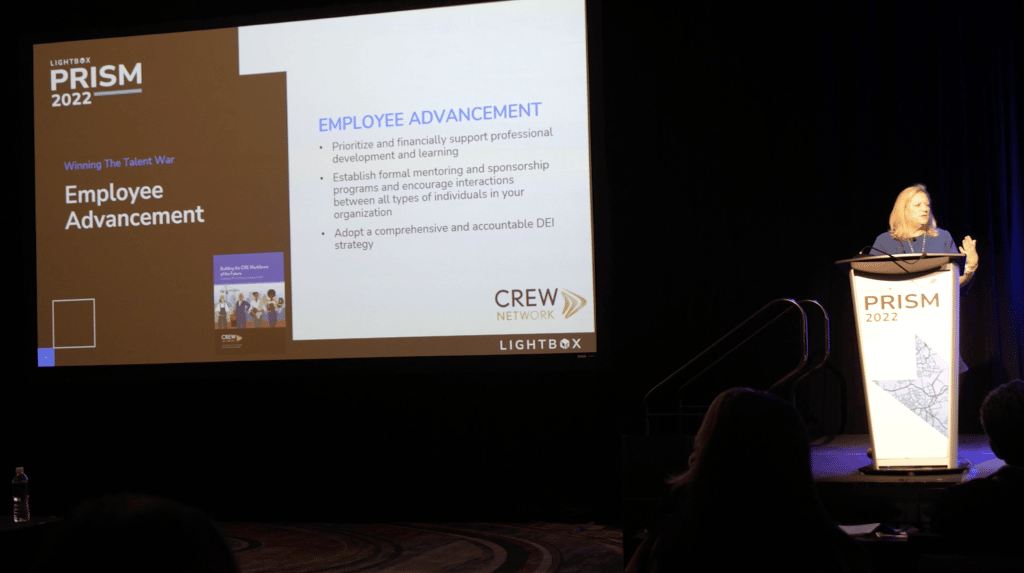The pandemic has radically altered the way people work, posing a major challenge for companies that must devise hybrid work protocols, determine how much office space they need and how it should be configured, and compete for workers in an increasingly tight labor market. Attendees at LightBox’s recent PRISM conference in Phoenix, Arizona, heard from leading subject-matter experts on the changing nature of the workplace and the personnel and hiring challenges many companies face.
Julia Georgules, head of research for the Americas at JLL, said there is a war for talent in today’s market, where the average number of job openings has doubled during past two-and-a-half years to about 10 million. Structural changes are shaking up the work landscape. Population growth is declining and Baby Boomers are retiring. This “silver tsunami” will have an impact on the labor market during the next 10 years. There’s also a skills mismatch. A Harvard study found that many jobs that didn’t require a college degree 20 years ago now require them, which means we’re eliminating people from the labor market who would have been otherwise been qualified to be employed.
Among the biggest challenges facing companies during the pandemic was how to develop protocols for remote and hybrid work. Early on, companies raised many questions. Is it a free-for-all? Do people get to make their own schedules? Do they get to pick what days they’re in the office? How do we plan office space around that? Those questions are being resolved as employers grow more confident about developing solutions and strategies that meet their needs. They’re offering flexibility, but are also requiring people to come into the office on certain days. Pre-Covid, 12 percent of the labor force worked from home full-time, according to U.S. Census data. That has increased to about 20 percent, where it is likely to settle.
Three Pillars in the Talent War—and the End of the Transactional Work Environment
Jeanette Flory-Sagan, founder of Cereus Asset Services, said there are three pillars to help companies win the talent war: recruitment, retention, and advancement. To successfully recruit, employers and company leaders must look in new places for talent, cast a wider net than they’ve historically done, and reach out to a wider range of colleges and industry associations, especially those with diverse memberships. It’s important for companies to be public on their websites and job listings about their values and their commitment to diversity, equity, and inclusion.

To retain talent, it’s critical to ensure that employees feel challenged and that they have opportunities to do new things. They must be adequately compensated and their values must be respected so that they will be less likely to leave. To foster advancement, companies must prioritize and provide resources to support professional development. This costs money, but ongoing training and learning, along with strong mentorship and sponsorship opportunities, will pay off in the long run by keeping your top talent in house.
Keesa Schreane, author of Gambling on Green: Uncovering the Balance Between Revenues, Reputations, and ESG and Corporations Compassion Culture, said there has been a shift in the way workers and their bosses interact. “We’re in a stage where we’re really in a relationship with our workers, with our colleagues, with our leaders. People come first. Relationships come first. No longer are we in a transactional environment where I supply you with a job and you supply me with eight hours of your day and that’s that. We are now in an environment where it’s really important that we understand the needs of those who we spend our time with.”
It’s impossible to retain every employee, but it’s worth the effort to keep in touch with those who leave. If you understand what’s important to them and what their career trajectory looks like, you might eventually offer them new opportunities in the firm.

Mentorship is very important for retaining talent, but it usually involves a one-on-one relationship. How do we scale that? How can we influence, how can we share information with others, as opposed to just having one connection? One solution is to create employee resource groups focused on a culture, a gender, or an ethnicity. We can take this a step further with reverse mentoring, which involves a two-way exchange between a junior employee and a senior executive. Both benefit from knowledge the other provides. After all, junior staff often have unique insights about the day-to-day life of a company. Finally, there is sponsorship, which is speaking for someone when they are not in the room. This kind of support is invaluable for career growth and for fostering employee retention.
In the end, to win the talent war you have to make people feel celebrated. Let them know they can innovate, build products, develop services, and drive the business forward. When they’re recognized and celebrated for who they are, overcoming challenges becomes that much easier.
Check out the LightBox PRISM Resource Hub
